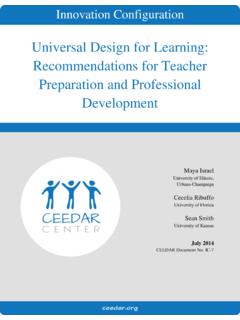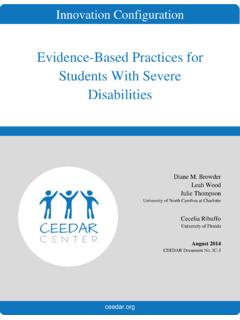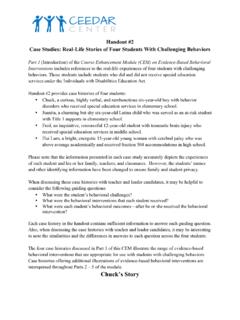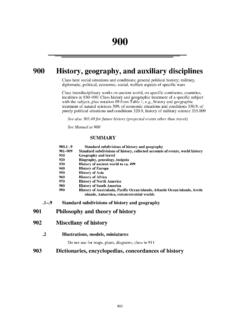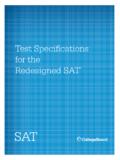Transcription of Culturally Responsive Teaching - CEEDAR
1 Innovation Configuration Culturally Responsive Teaching Terese C. Aceves Loyola Marymount University Michael J. Orosco University of California-Riverside July 2014. CEEDAR Document No. IC-2. Disclaimer: This content was produced under Department of Education, Office of Special Education Programs, Award No. H325A120003. Bonnie Jones and David Guardino serve as the project officers. The views expressed herein do not necessarily represent the positions or polices of the Department of Education. No official endorsement by the Department of Education of any product, commodity, service, or enterprise mentioned in this website is intended or should be inferred.
2 Recommended Citation: Aceves, T. C., & Orosco, M. J. (2014). Culturally Responsive Teaching (Document No. IC-2). Retrieved from University of Florida, Collaboration for Effective Educator, Development, Accountability, and Reform Center website: Note: There are no copyright restrictions on this document; however, please use the proper citation. Page 2 of 37. Table of Contents List of Tables .. 5. Innovation Configuration for Culturally Responsive 6. Definition of Culturally Responsive Teaching .. 7. Relevant Themes of Culturally Responsive Teaching .. 9.
3 Instructional Engagement .. 9. Culture, Language, and Racial Identity .. 9. Multicultural 10. High Expectations .. 11. Critical 11. Social Justice .. 12. Emerging Evidence-Based Culturally Responsive Teaching Practices .. 13. Collaborative Teaching .. 13. Responsive Feedback .. 14. 15. Instructional Scaffolding .. 16. Recommended Culturally Responsive Teaching Approaches and Considerations .. 17. Problem-Solving Approach .. 17. Child-Centered 18. Assessments .. 19. Materials .. 20. Conclusion .. 21. References .. 23. Page 3 of 37. Appendix: Culturally Responsive Teaching Innovation Configuration.
4 33. Page 4 of 37. List of Tables Table 1: Culturally Responsive Teaching Practices .. 9. Page 5 of 37. Innovation Configuration for Culturally Responsive Teaching This paper features an innovation configuration (IC) matrix that can guide teacher preparation professionals in the development of appropriate Culturally Responsive Teaching (CRT) content. This matrix appears in the Appendix. With the implementation of any innovation comes a continuum of configurations of implementation from non-use to the ideal. ICs are organized around two dimensions: essential components and degree of implementation (Hall & Hord, 1987; Roy & Hord, 2004).
5 Essential components of the IC along with descriptors and examples to guide application of the criteria to course work, standards, and classroom practices are listed in the rows of the far left column of the matrix. Several levels of implementation are defined in the top row of the matrix. For example, no mention of the essential component is the lowest level of implementation and would receive a score of zero. Increasing levels of implementation receive progressively higher scores. ICs have been used in the development and implementation of educational innovations for at least 30 years (Hall & Hord, 2001; Hall, Loucks, Rutherford, & Newton, 1975; Hord, Rutherford, Huling-Austin, & Hall, 1987; Roy & Hord, 2004).
6 Experts studying educational change in a national research center originally developed these tools, which are used for professional development (PD) in the Concerns-Based Adoption Model (CBAM). The tools have also been used for program evaluation (Hall & Hord, 2001; Roy & Hord, 2004). Use of this tool to evaluate course syllabi can help teacher preparation leaders ensure that they emphasize proactive, preventative approaches instead of exclusive reliance on behavior reduction strategies. The IC included in the Appendix of this paper is designed for teacher preparation programs, although it can be modified as an observation tool for PD purposes.
7 The Collaboration for Effective Educator, Development, Accountability, and Reform ( CEEDAR ) Center ICs are extensions of the seven ICs originally created by the National Comprehensive Center for Teacher Quality (NCCTQ). NCCTQ professionals wrote the above description. Page 6 of 37. A large and increasing proportion ( , 48% in 2011 compared to 39% in 2001) of the student population in the United States comes from homes that are Culturally and linguistically diverse (CLD; Department of Education, 2014). This demographic change has created cause for concern as research shows that a student's race, ethnicity, cultural background, and other variables ( , poverty, assessment practices, systemic issues, lack of PD opportunities for teachers, institutional racism) significantly influence the student's achievement ( , Harry &.)
8 Klingner, 2006; Orosco & Klingner, 2010; Skiba et al., 2011). Addressing the unique needs of CLD students is one of the major challenges facing public education today because many teachers are inadequately prepared ( , with relevant content knowledge, experience, training) to address CLD students' learning needs ( , Au, 2009; Cummins, 2007). This inadequate preparation can create a cultural gap between teachers and students (Gay, 2010; Ladson-Billings, 2009) and can limit educators' abilities to choose effective instructional practices or materials because way too often, teachers and instructional contexts are developed to benefit students from White middle and high socioeconomic status (SES) backgrounds, voiding the cultural and linguistic characteristics of diverse learners (Orosco, 2010; Orosco & O'Connor, 2011).
9 CRT, defined in the next section, can help address this disparity. Definition of Culturally Responsive Teaching In defining CRT, it is important to draw from the work of Gay (2010), Nieto, Bode, Kang, and Raible (2008), and Ladson-Billings (2009). Teachers who utilize CRT practices value students' cultural and linguistic resources and view this knowledge as capital to build upon rather than as a barrier to learning. These teachers use this capital ( , personal experiences and interests) as the basis for instructional connections to facilitate student learning and development.
10 Teachers who use CRT apply interactive, collaborative Teaching methods, strategies, and ways of Page 7 of 37. interacting that support CLD students' cultural, linguistic, and racial experiences and integrate the methods with evidence-based practices (EBPs; , Harlin & Souto-Manning, 2009; Hersi &. Watkinson, 2012; Nieto et al., 2008; Santamaria, 2009). The student population in United States public schools is becoming increasingly CLD;. however, teachers and school leaders remain fairly monoracial ( Department of Education, 2013). In 2012, 83% percent of full-time public school teachers were White, 7% were Black, 7%.


